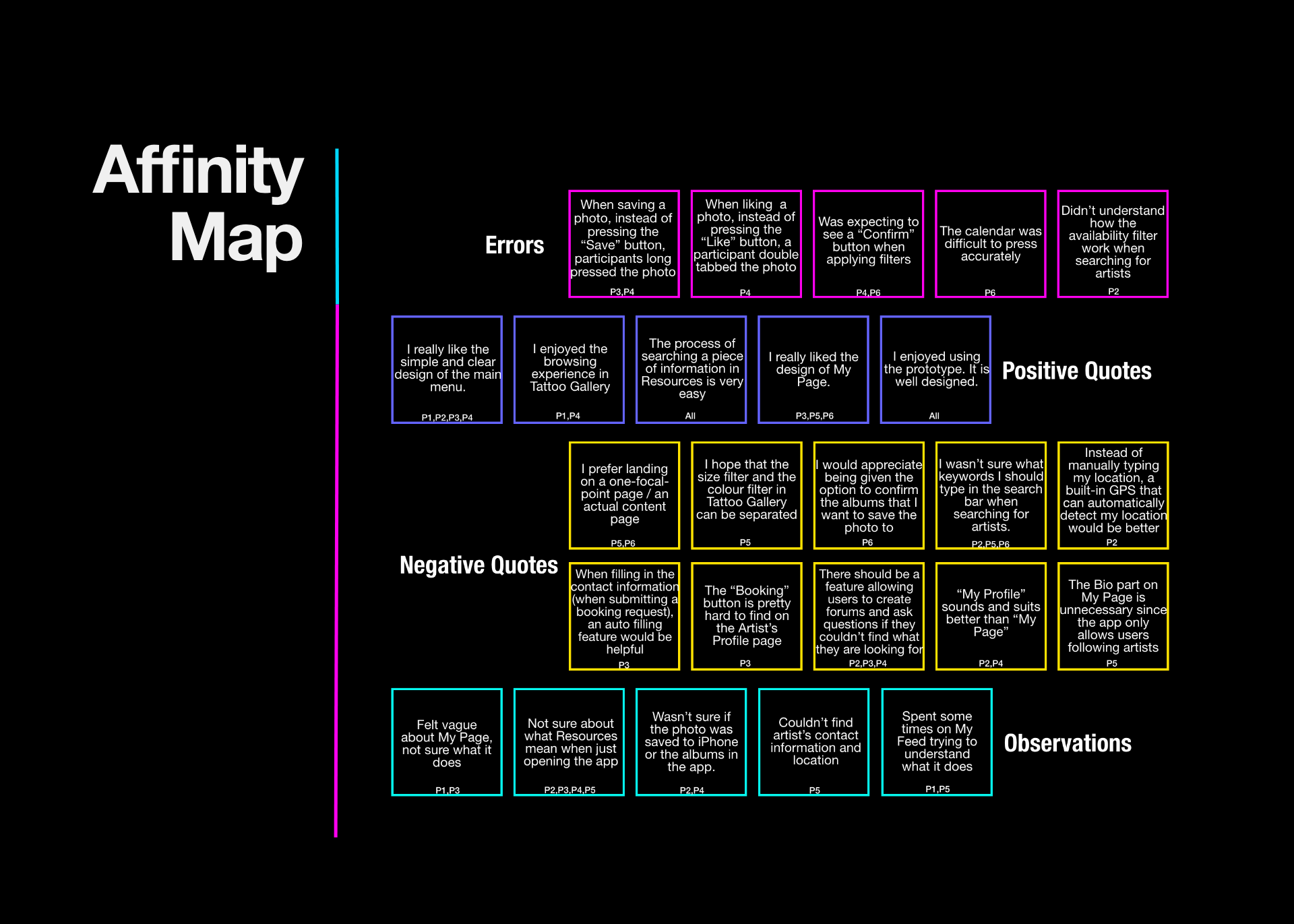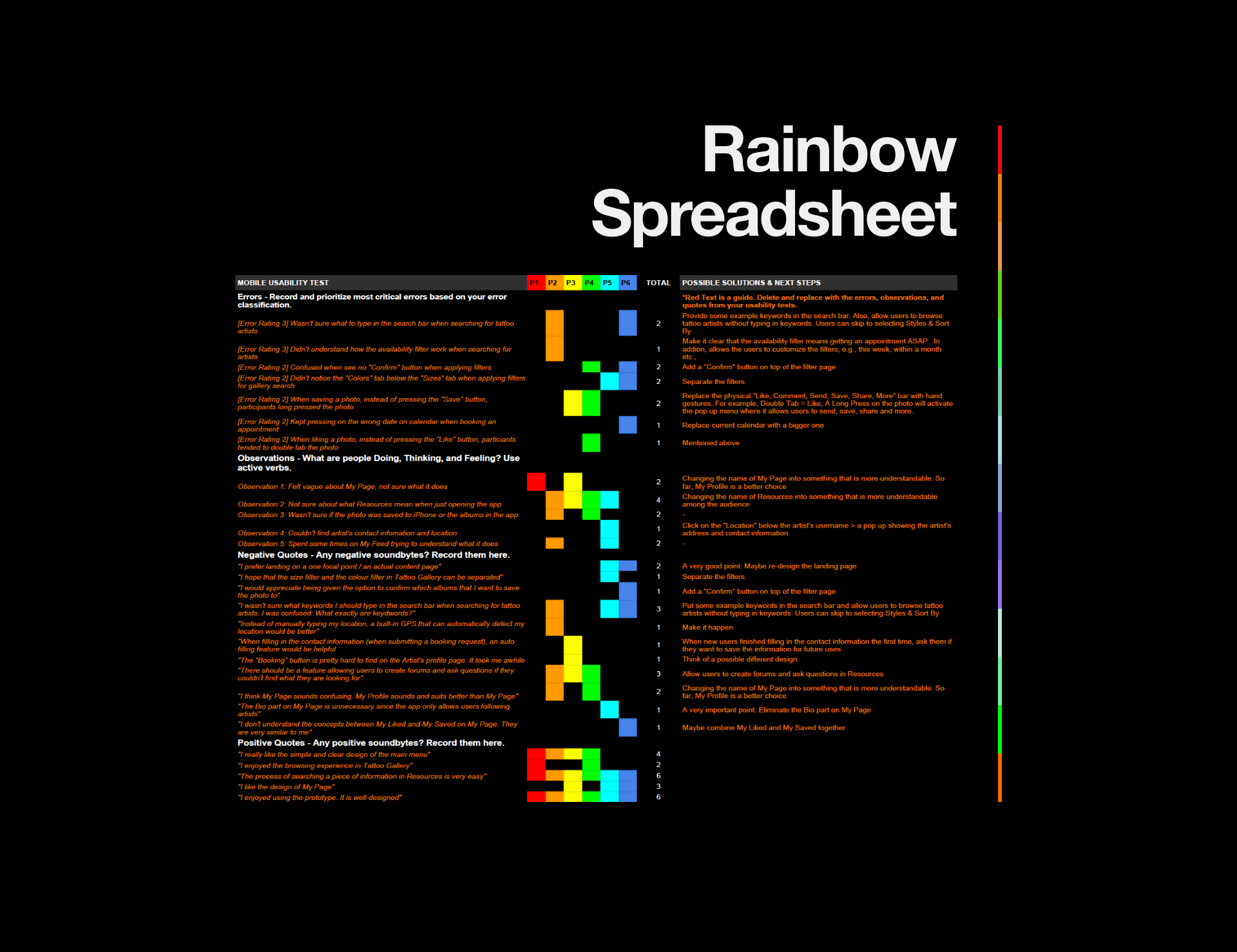Get Inked
A platform for tattoo audience to explore inspirations, discover trending designs, and connect with artists
About
Get Inked is a mobile app for tattoo customers to explore all things tattoo related.
The application helps tattoo audience discover inspirations, find talented artists according to a number of preferences (e.g., styles, locations, popularity, availability, etc., ), as well as chat and book the artist for different types of appointments.
Timeline: Nov 2019 - Mar 2020
Project Type: Capstone Project
My Role: User Research / Competitive Analysis/ Journey Mapping / Sketching / Wireframing / Visual Design / User Testing
Design Tools: Adobe XD
Background
As someone who had both great and bad tattoo experience in the past, I very much understand the happiness and the stress tattoos can impose on us. As a digital thinker, I always wonder what can be done to improve the overall process.
There are a few existing tools designed specifically for tattoo audience, but neither seems to address the complexity and emotional element of the tattoo journey. Despite the popularity of the industry, there is really little focus on tattoo audience from a design and technology standpoint.
Problem Statement
Planning and preparing for getting a tattoo could be a long and lengthy process. Exploring inspirations, deciding the designs, and finding the artist who understands and listens to the needs, could take months.
How can we make this overall experience more efficient, and more enjoyable?
Project Goal:
Help tattoo audience make better-informed decisions by improving their experience in exploring tattoo content, and finding the right artist to execute the design
Target Audience
People who are interested in tattoos and between the age of 18-40 years old
User Research
In order to learn more about the problem space and to uncover tattoo audience’s pain points from their perspectives, I reached out to an online tattoo interests group and my own friends who have tattoos experiences in the past or are interested in getting a tattoo in the future for user surveys. I specifically focused on the following areas:
How do tattoo users feel about the current browsing experience other tools offer?
What are some of the biggest frustrations and challenges tattoo audience currently experience?
How do people decide on an artist?
Why do some people regret their tattoos?
I conducted a total of 43 User Surveys. This is one of the research analysis that I did.
After I have gained insights on user’s behaviours and opinions from the surveys, I then conducted interviews to learn more about why tattoo customers feel certain ways and the reasons for their opinions.
Based on the insights that I gained from the user research, I was able to discovered some key painpoints that tattoo customers are experience.
Key Painpoints
People feel most frustrated when trying to find the right tattoo artist.
The main reason that they feel this way is that there are so many factors (e.g., styles, quality of the work, credibility, price, availability, location etc.,) involved in the decision making process and it is not easy to meet all of the desired criteria.
People also feel frustrated when trying to decide on the final design.
Because 1) they don’t know what to get, and when they browse inspiration online, they are easily overwhelmed by the amount of available content on the internet.
2) they are being careful and cautious so that they want to explore as many options as possible before making up their mind.
Additional Insights
People use different platforms for different needs. Google, Instagram and Pinterest are common and popular tools when checking out tattoo knowledge, inspirations, designs and artists.
When it comes to choosing a tattoo artist, what people value the most (equally important) are 1) if the artist has a good portfolio, 2) whether the artist has good reviews, 3) if the style of the artist matches with the desired design in mind
78% of the participants don’t know any tattoo specific websites or applications and that indeed shows that there is really not much attention on the tattoo audience.
Competitive Analysis
Before moving forward to ideation, I explored some existing products in the market that have similar objectives. Not only did I want to find out the existing approaches other similar products use to serve the audience, but also their strengths and weaknesses from a UX standpoint.
I chose Tattoodo as the main competitor and I specifically focus on its content, functionality, usability, and navigation.
Concluding My Findings:
Overwhelming Content
When browsing, the content appears very messy and disorganized. The lacking of sort by, filters and advanced search features would easily frustrate the targeted users.
Overcrowded Interface
Tattoodo separated similar content too often while didn’t break down big chunks of information properly, thus, making its interface overcrowded with all sorts of different types of information.
Not Enough Artists
Tattoo artists and businesses need to pay extra subscription fees in order to accept bookings, making them hesitate to do so. The result being users can only see a very limited number of available artists.
User Persona
I consolidated the insights in two main personas, Theresa, the first timer and Justin, who has tattoo regrets and is looking for an artist to do a cover up tattoo. These personas referenced frequently throughout the project to create empathy and guide design decisions.
“The interest in getting a tattoo slowly grew on me.
It is fascinating that ink can be so expressive. I want my first tattoo to be meaningful, stunning, and well-executed.”
—Theresa, the first-timer
“I am looking for a good tattoo artist to cover and redo the tattoo that I have regretted and turn it into something new.”
—Justin, the casual enthusiast
Journey Map
In order to better envision the process users like Theresa and Justin go through to complete certain goals, I mapped out their journey and tried to visualize their experience and frustration when interacting with existing tools so that I can identify opportunities for design improvement.
Opportunities
I defined some key opportunities and rooms for improvements to optimize user’s experience based on the insights gained from journey mapping.
Key Insights
Based on research findings and insights gained from the user personas and journey maps, I believed by creating a tattoo community where people can easily search and compare tattoo designs, discover, communicate and book the right tattoo artists, users can make better-informed decisions about getting inked and no longer need to use multiple platforms at the same time.
Identifying helpful features
— Discover tattoo ideas based on different categories like styles, sizes, and colors etc.,
— Save design ideas so that users can compare them later
— Find tattoo artist based on user preferences like styles, locations, ratings, popularity, availability etc.,
— Chat with tattoo artist, book appointment, and understand pricing directly on the app
Sitemap
I then created the sitemap to help me envision the overall navigations and the hierarchy so that I can understand what content should be provided at what page.
And how they connect with other features…
Ideation & Sketches
Mid-Fidelity Wireframes
User Testing
The purpose of the test was to observe users’ first impressions, general attitudes towards Get Inked’s Mid-Fidelity Prototypes. Specifically, I was interested to find out if the users find the features helpful and how difficult it is to perform key features.
Key Objectives
1. Do users enjoy the browsing experience in Tattoo Gallery?
2. How helpful are the filters and the sort by features?
3. Do they know how to find a tattoo artist and book an appointment with the artist?
4. How easily can they navigate My Profile and do they find the interface intuitive?


I compiled all the feedback collected during the test into an Affinity Map and managed to organize the information in a Rainbow Spreadsheet to document their behavioral patterns and help me analyze the input.
Test Results & Iterations
Final Design
Onboarding
Explore Tattoo Gallery
Find & Chat With Artist
Book Your Favourite Artist
Manage Your Profile
Retrospective
What went well
The Competitive Analysis has helped me gain a good understanding of what works and what doesn’t work for tattoo audience. Also, involving the users early and actively throughout the design process has helped me tremendously in understanding the users’ mindsets and the problems they are facing. The feedback I received from the usability testing was very positive, as a result, I only made moderate changes to the original prototype.
What I missed
For the purposes of this project, I put my main focus on the tattoo audience. What I should also do is to research the other key player in this experience, tattoo artists, to incorporate elements from their point of view and to get their feedback on the artist portfolio page and the booking experience that we provide to the tattoo audience.
Next Steps
The next step would be to conduct another round of testing on the iterated prototype to further improve the usability of the app. I would also love to explore more about the opportunities and design the corresponding app for the supply side (tattoo artists) of the marketplace.



















